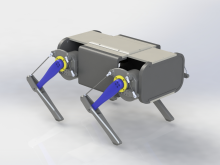Dyno - Quadruped Robot
Background
Team Formation
For our senior design project, we are all a part of UC Irvine’s Formula SAE team. We wanted to create a larger project spanning across multiple groups since we are used to working together. We decided on a quadruped robot, which integrates several senior design projects together into one system. Our portion of the project described here is the robot itself, however there are two other teams working with us: A claw team working on a claw attachable to our robot dog, and an EECS team working on motor controllers so we can integrate higher power brushless DC motors into our dog later on.
Natural Disasters
Over the last 4 years, the United States has been victim to multiple tragic natural disasters. These events require first responders to plan for as many scenarios as possible. Technology in this area needs more attention, and engineers can to work to provide solutions to problems. Creating a unmanned system that can, deliver supplies, move live wires, or identify trapped individuals is our team's goal. These could be deployed after hurricanes, tornados, fires or earthquakes.
Concept
We focused on the robot dog concept because we wanted the form of our senior design project to replicate that of the Boston Dynamics robot dog. We were amazed with its fluid movement and mobility. The Boston Dynamics robot dog achieves this through many advanced engineering design choices, like brushless DC motors, clever motor placement, and usage of advanced materials like carbon fiber.
However, this robot costs tens of thousands of dollars, so we conducted background research on several other options within our budget. We looked into similar senior-level design projects such as DINGO, a capstone project for a group of student engineers from Monash University. There are also open-source projects from YouTubers within the field, such as Aaed Musa’s TOPS.
Defining the Project
Now that we had inspiration for a form that our project would take, we then created a problem definition that would set needs that would drive our design. This robot project would produce a robust, maneuverable, low-cost robot to aid in disaster situations. This problem definition would serve as the main driver of our needs and requirements, which drive the design. For example, a robot that would meet these needs would need the enhanced mobility from four legs and would benefit from the use of a claw to move debris. Our overall goals and objectives are further detailed below.
Goals and Objectives
Design Goals
Overall, we want a robot that can survive and traverse adverse conditions, specifically accessing locations where wheel or track-driven robots would be at a disadvantage. Here are specific qualities we want our final design to have:
- 4 legs (3 DOF per leg)
- Low-cost
- Portability / lightweight
- Resistant to adverse weather conditions (rain, dust, etc.)
- Resistant to impacts
- Support for claw arm integration
- Ability to climb over small obstacles
- Inexpensive
Objectives
Our objective by the end of this quarter is to demonstrate a working prototype of Dyno. We will showcase its ability to walk in a straight line and step up a small ledge, as these are the types of conditions it would have to navigate if implemented in the field. Working with our short timeline and tight budget, we want Dyno to serve as a proof of concept for cost-effective solutions to providing natural disaster aid. We also want to demonstrate our capabilities as engineers to develop this project and build a prototype as we follow the steps of the engineering design process.
Milestones
Here are the major milestones for this project during the 2024 Fall quarter:
- Weeks 1, 2, and 3 - Form a Knowledge Basis on the Engineering Design Process
- Week 4 - Brainstorming and Problem Definition
- Week 5 - Concept Generation and Decision-Making
- Week 6 - Completion of Initial Design
- Week 7 - Preliminary Design Review Reflection and Redesign
- Week 8 - Final Design and Prototyping
- Week 9 - Full Manufacturing and Testing
- Week 10 - Controls Testing and Final Touches
Team Contacts
Abraham Diaz Robles (adiazrob@uci.edu)
Logan Somvangh Sim (lssim@uci.edu)
Christopher Todd Busby (busbyc@uci.edu)
Jonny Holt (jholt2@uci.edu)
Aden Leggio (aleggio@uci.edu)
Aidan Siaotong (siaotona@uci.edu)
Team Sponsor
Shorbagy Mohamed (mohamem2@uci.edu)

